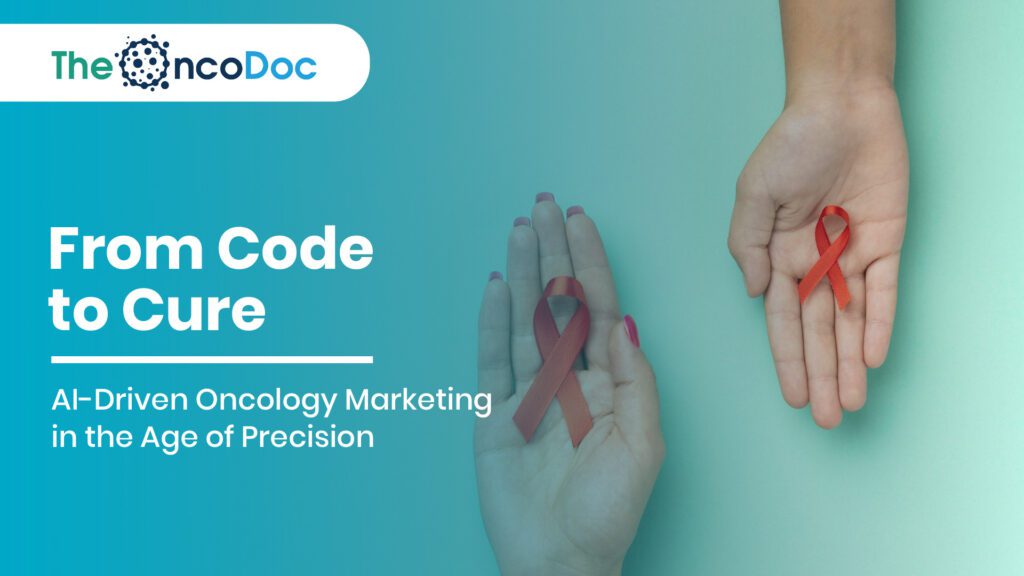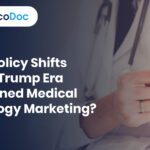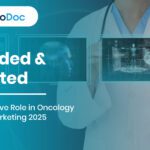Introduction: From Campaigns to Care Continuums
In 2025, oncology pharma marketing has grown beyond awareness campaigns and physician outreach. It’s now about driving proactive health behaviors, empowering patients with precise knowledge, and enabling real-world clinical outcomes. With cancer care becoming more interdisciplinary, digital-first, and emotionally complex, pharma marketers must play a more intelligent and integrated role.
This evolution is powered by Artificial Intelligence (AI), which is transforming not just how campaigns are built, but how impact is measured. Marketing no longer ends at awareness; it begins with early detection nudges and continues through survivor engagement and beyond.
This article explores cutting-edge shifts redefining oncology marketing, from virtual tumor boards to hyperlocal WhatsApp campaigns, supported by AI, behavioral science, and human empathy.
1. Precision Persona Mapping through AI
Gone are the days of broad segmentation. Today’s AI-driven tools dissect the oncology audience into behavioral, emotional, and psychographic personas. A typical AI persona model may include:
- “The Anxious Googler”: Frequently searches for vague symptoms and needs reassurance-based messaging.
- “The Compliant Caregiver”: Engaged in tracking follow-ups and insurance workflows for loved ones.
- “The Skeptical Diagnosed”: Recently diagnosed and prone to misinformation or avoidance behavior.
Marketers now use NLP (Natural Language Processing) to analyze online forums, symptom checkers, and chatbot conversations to design precision narratives for each persona. This ensures that every message, nudge, or video lands with emotional relevance.
2. The Empathy Engine: Emotional AI in Oncology Ads
Emotion-sensing algorithms are redefining message testing. Rather than rely solely on A/B testing, pharma marketers now deploy emotional AI to analyze facial microexpressions and voice tone reactions to marketing stimuli.
A pan-India emotional resonance study in 2025 revealed:
- Ads with survivor voiceovers elicited 38% higher engagement.
- Videos ending in hopeful recovery scenarios scored 45% better on viewer intent to screen.
- Emotionally neutral ads underperformed in recall by 26%.
Thus, AI now powers not just delivery, but emotional calibration.
3. Conversational Commerce in Oncology: From Chatbots to Carebots
These days, chatbots for pharmaceuticals are more than just FAQs. They’re evolving into carebots that:
- Conduct guided pre-screening symptom journeys.
- Offer emotional check-ins using sentiment analysis.
- Assist caregivers in medication scheduling and hospital visits.
These bots are integrated into platforms like Telegram, WhatsApp, and even IVR-based voice calls for low-literacy areas.
This automation creates a 24/7 support loop, freeing up human resources while increasing patient compliance.
4. The Geo-Predictive Cancer Atlas
AI-enabled heatmaps now help pharma brands detect early warning zones based on public health records, search behaviors, and diagnostic center footfalls. For example:
- An unexplained spike in searches for “mouth ulcers” + “bleeding gums” in a UP district might prompt an oral cancer awareness push.
- An increase in women searching “irregular periods after 40” in Kerala could trigger a hyperlocal ovarian cancer campaign.
Compared to conventional static advertisements, such geospatial campaigns have demonstrated a 21% higher return on investment.
5. Hyper-Personalized Influencer Ecosystems
While oncologists remain central, modern campaigns leverage a multi-layered influencer stack:
- Onco-nutritionists: Sharing diet tips post-chemotherapy.
- Cancer survivors: Conducting Q&A sessions on Instagram Live.
- Regional radio jockeys: Advocating for screening in local dialects.
Brands now build entire ecosystems where influencers are algorithmically matched to patient personas, maximizing emotional connection and message retention.
6. AI-Based Multilingual Content Generation
India’s linguistic diversity poses a unique marketing challenge. AI translation engines now allow pharma teams to create 100+ versions of a single awareness script, not just linguistically but culturally localized.
For example:
- A Marathi video on tobacco-induced cancers may reference local chewing habits.
- A Tamil post-chemotherapy care video will highlight dietary recovery using regionally consumed foods like kanji or rasam.
This improves campaign relatability and comprehension in Tier-2 and Tier-3 cities in India.
7. Voice Technology in Oncology: The Emergence of “Cancer Whisperers”
AI-powered voice assistants are now embedded in pharma-led platforms, delivering cancer-related guidance through:
- Voice-based symptom checkers on JioPhone and smart speakers.
- Dial-in educational IVRs in Hindi, Bengali, Telugu, etc.
- Voice-activated WhatsApp journeys for senior patients.
These tools are invaluable in communities with low literacy or screen fatigue.
8. Gamified Micro-Behaviors: Nudging with Neuro-Marketing
Gamification is used not just for engagement, but for health nudging. Tactics include:
- Screening leaderboards in housing societies.
- Digital health coins awarded for completing risk assessments.
- Survivor badge systems encouraging post-treatment engagement.
These interactive strategies improve screening participation by up to 32%, particularly in Gen Z and millennial caregivers.
9. Oncology and Wearables: Data as Dialogue
Smart rings, bands, and glucose monitors are now being harnessed to track pre-diagnosis anomalies like:
- Unexplained fatigue patterns
- Elevated resting heart rates
- Chronic inflammation indicators
Pharma brands collaborate with wearable companies to push contextual alerts, such as: “Your vitals suggest a consultation might help. Here’s a free e-consult code.”
This transforms passive data into timely action.
10. Campaign Success Reimagined: From Clicks to Clinical Impact
Traditional metrics (CTR, impressions) are being replaced by real-world metrics such as:
- Screening conversion rate
- Referral uplift among GPs
- Chatbot triage-to-consultation pipeline
This redefinition helps align marketing closer to patient outcomes.
This data clearly positions conversational and peer-driven platforms as high-impact.
12. Oncology Metaverse & Virtual Tumor Boards
Pharma companies are now sponsoring:
- VR-based tumor exploration tools for oncologists.
- Digital tumor boards connecting GPs in rural areas with super-specialists.
- AR simulations for drug mechanism demonstrations.
Such immersive tools are reshaping HCP education and brand value perception simultaneously.
13. KOLs in the Age of AI
While key opinion leaders (KOLs) still drive credibility, AI is now used to:
- Identify emerging micro-KOLs on social media with rising trust indices.
- Analyze which physician’s videos receive the most patient interaction.
- Suggest co-creation opportunities based on emotional sentiment data.
KOL strategy has thus evolved from volume outreach to relevance resonance.
14. Post-Treatment Engagement & Digital Survivorship
Marketing doesn’t stop at diagnosis. Pharma brands now offer:
- Post-chemo emotional health webinars.
- Drug adherence apps with dose reminders + motivational quotes.
- Tele-counseling support groups moderated by oncology nurses.
Survivor marketing builds loyalty, boosts adherence, and powers real-world evidence generation for clinical teams.
15. AI for Myth-Busting Campaigns
AI social listening now detects misinformation patterns like:
- “Papaya leaves cure cancer”
- “Cancer spreads via biopsy”
Triggered responses include:
- Verified video explanations from oncologists
- Regional Facebook Lives to debunk myths
- Fact-check carousels pushed via WhatsApp
This real-time myth correction boosts campaign trust and patient safety.
16. Oncology + AI + Ethics = Trust Frameworks
With AI involved in sensitive targeting, ethical marketing becomes critical. Brands now implement:
- Opt-in consent mechanisms before pushing health alerts.
- Bias audits to ensure fair campaign reach.
- Data minimization strategies in caregiver content.
Transparent AI use builds long-term credibility, especially in oncology, where fear and hope coexist.
17. Building AI-Ready Oncology Teams
To succeed in AI-integrated marketing, pharma teams now upskill across:
- Prompt engineering for better AI outputs.
- No-code campaign builders for dynamic hyperlocal pivots.
- Multilingual content mapping for vernacular scale-up.
Agility, not scale alone, determines campaign excellence in 2025.
18. NGO-Pharma Co-Marketing Models
Impact-first partnerships now flourish between pharma and public health NGOs. Success models include:
- Co-funded screening trucks with branding on one side and public health content on the other.
- Free diagnostic e-vouchers distributed via ASHA workers during home visits.
- Co-branded radio awareness series in Northeast India.
Such models deliver health equity at scale, and position pharma as a healthcare ally, not just a commercial entity.
19. Real-Time Campaign Pivoting with AI Dashboards
Marketing teams now operate with war room dashboards showing:
- Daily symptom search spikes
- Chatbot interaction heatmaps
- Campaign emotional feedback scores
If a video causes fear instead of action, it’s swapped out in real time. AI dashboards make campaign pivoting instant and intelligence-backed.
20. What’s Next? Predictive, Preventive, Participative Marketing
The oncology marketing flywheel is rapidly evolving:
- Predictive: Know where and when cancer risks emerge before the patient does.
- Preventive: Drive early screenings and lifestyle changes, not just diagnosis.
- Participative: Empower survivors, caregivers, and micro-influencers to co-own the message.
AI is not replacing the marketer, it’s upgrading them. The future is a blend of machine precision and human empathy.
21. Digital Twins in Oncology Education and Engagement
The concept of “digital twins”, virtual replicas of physical systems, has now entered oncology. Pharma companies are developing patient-specific digital avatars that model tumor growth, treatment responses, and side effects using real-time clinical data.
Here’s how this is transforming marketing:
- For HCPs: Marketers collaborate with med-tech teams to deliver virtual CME modules where oncologists “treat” a digital twin of a patient with certain biomarkers, testing how a therapy may perform.
- For patients: Educative campaigns offer simplified digital simulations showing how early screening or lifestyle changes could alter one’s cancer risk trajectory.
This makes awareness personalized, visual, and dramatically more impactful.
A study from AIHealth India 2025 showed that patients exposed to digital twin simulations were 2.7x more likely to complete their recommended cancer screening within a month.
22. Nano-Influencers and Community Health Leaders
In India’s semi-urban belts, nano-influencers (social media figures with 1K–10K followers) and community health educators are emerging as the most trusted voices in oncology communication.
Unlike mass influencers, they:
- Share hyper-personal, relatable experiences (e.g., a mother sharing her cervical cancer journey on YouTube).
- Often live in the same region or language group as their audience.
- Have higher engagement-to-follower ratios and influence real behaviors, not just awareness.
Pharma companies are building AI dashboards to map and vet such nano-influencers across Indian districts based on:
- Sentiment strength in comments
- Engagement velocity
- Topic relevance (oncology focus)
By activating hundreds of these influencers in parallel, brands achieve deep cultural immersion with scale.
23. The Shift to Longitudinal Marketing Journeys
Pharma marketers are now building “continuity campaigns” that follow a patient or caregiver across the entire oncology lifecycle:
- Symptom awareness →
- Screening conversion →
- Treatment education →
- Adherence and emotional support →
- Survivorship and recurrence monitoring
Instead of standalone campaigns, these journeys are powered by AI-based CRM systems that:
- Deliver timely nudges based on user behavior.
- Adjust tone and message as the patient progresses.
- Flag drop-offs in engagement for human follow-up.
This marketing approach mimics care pathways, supporting the patient as a human, not a data point.
24. AI-Assisted CME for Oncology Sales Reps
In 2025, pharma sales reps are no longer just product evangelists, they’re educational enablers. To equip them, companies are using:
- AI tutors that quiz reps before doctor visits.
- Simulated oncologist conversations using language models.
- Personalized coaching dashboards that flag knowledge gaps.
These tools ensure reps can confidently answer complex questions like:
- “What are the latest trial updates on PD-L1 inhibitors?”
- “What does real-world evidence say about this biosimilar?”
A survey by IndiaRepTech (2025) revealed that AI-assisted field force tools improved doctor satisfaction scores by 31% in oncology interactions.
This closes the trust gap between reps and time-starved oncologists.
25. Integrating Oncology Marketing into the Preventive Health Economy
With cancer cases rising among younger populations, especially lifestyle-related cancers (e.g., colorectal, oral, breast), pharma brands are moving upstream, into prevention marketing.
AI tools now help:
- Identify at-risk populations before symptoms arise.
- Integrate cancer screening into existing wellness programs, e.g., diabetes clinics, workplace health drives.
- Collaborate with insurance and health-tech platforms to incentivize screenings via cashback, health points, or discounts.
For instance, a colorectal cancer prevention campaign integrated into a nutrition tracking app led to a 22% screening conversion among 35–50-year-old male users in Tier-1 cities.
This blurs the line between pharma marketing and public health impact, elevating the marketer’s role as a preventive health architect.
Conclusion: The Reimagined Role of the Oncology Pharma Marketer
From virtual carebots to emotional AI, from nano-influencers to digital twins, the oncology pharma marketer of today wears many hats: technologist, empath, educator, and social innovator.
They are no longer pushing molecules, they are curating experiences, triggering life-saving actions, and building trust ecosystems that stretch from diagnosis to survivorship.
The next five years will see even more radical innovation. AI will:
- Predict individual relapse risks and personalize post-treatment care paths.
- Automatically generate culturally nuanced content at scale.
- Suggest optimal campaign timings based on hormonal, emotional, or seasonal factors.
But through it all, empathy will remain the central pillar. Because even the most sophisticated AI cannot replace the healing power of trust.
And it is trust, built campaign by campaign, conversation by conversation, that will determine who leads in the age of intelligent oncology marketing.
The Oncodoc team is a group of passionate healthcare and marketing professionals dedicated to delivering accurate, engaging, and impactful content. With expertise across medical research, digital strategy, and clinical communication, the team focuses on empowering healthcare professionals and patients alike. Through evidence-based insights and innovative storytelling, Hidoc aims to bridge the gap between medicine and digital engagement, promoting wellness and informed decision-making.



